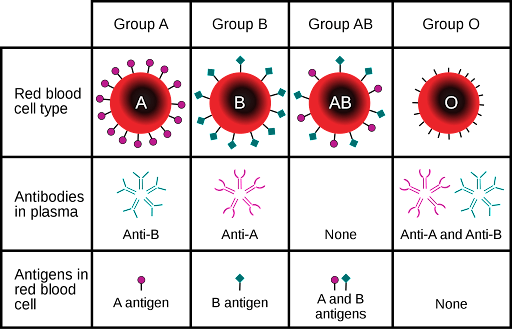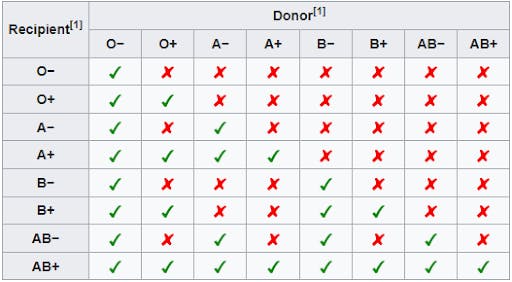TL;DR Science: Blood Types
By Angelo Chen
September 22, 2021 · 4 minute read
We’ve all heard of different blood types, and odds are you know what yours is (if not, you probably should find out, in case of a medical emergency). But what’s the difference between all these blood types, besides just their letters? And what do these + and - signs mean? This week, we’ll be taking a look at all the different types of blood, and what these differences mean.
What is Blood?
Before we begin about blood types, we first need to investigate blood as a whole. Within blood there are 4 main parts: red blood cells, white blood cells, platelets, and plasma.
- Red blood cells are in charge of transporting oxygen around the body.
- White blood cells play a key role in the body’s immune system, to fight off disease.
- Platelets are key to help your body form clots and stop bleeding from wounds.
- Plasma is a liquid that transports vital nutrients needed for cell function around the body.
These are all components of blood, and as you can see, they each play a major role in your life. Blood types however are primarily determined by your red blood cells and plasma.
The ABO System
The ABO system is the most important factor in differentiating blood types. There are four groups in the ABO system: A, B, AB, and O. A blood’s ABO typing is determined by the antigens present on the surface of red blood cells, as well as the antibodies present in the blood’s plasma.
Antibodies are Y-shaped proteins that bind to antigens, similar to a lock and key. When they bind, the antibodies effectively neutralize the pathogen it is bound to, or disfigure it into a shape your immune system can more easily dispose of. Antigens are proteins that exist on the surface of some cells and pathogens.

With the table above, we can see the characteristics of each blood type, and the differences in the antibodies and antigens present in each blood group. For example, blood type A has A antigens and Anti-B antibodies. This means that this blood type has antibodies that will attack cells with B antigens, and A antigens that would be attacked by Anti-A antibodies. Things can get confusing rather quickly, so it may be best to refer to the table above when needed.
The Rh System
Along with the ABO System, there is also the Rh, short for rhesus, system, which is what the + or - sign on the ends of blood types means. The Rh system is another classification of antigens present in the blood, but the most important one is the Rh(D) antigen (commonly known as the Rh factor) because it is most involved in the immune system’s response to foreign blood.
The Rh(D) antigen is a specific antigen that can trigger violent immune responses and is thus denoted in blood types by a +, indicating the presence of the antigen, or a -, indicating the absence of it. Those without this antigen (negative blood types) produce anti-D antibodies, which means they cannot take blood with Rh(D) antigens (positive blood types). This is why negative blood types can only receive from negative blood types, but positive blood types can receive from either.
Blood Transfusion
Understanding blood types is most important in blood transfusions because certain blood types are only compatible with specific other types. This is because of the antibodies found (or not found) in blood. Type A blood, for example, contains anti-B antibodies, so type B and AB blood, which have B antigens will be attacked by the immune system, or rejected by the body. For children and pregnant women especially, this adverse reaction can be fatal.
Based on the characteristics of your blood, there are some blood types you may or may not be able to receive. If a person’s blood has antibodies for a certain type, it cannot receive blood from that type. For instance, type B blood has antibodies for A, so people with type B blood cannot receive type A blood.

If you’re still unsure, check out this video by Bozeman Science explaining blood types with some really helpful diagrams!
Also check out Blood Types Explained - A, B, AB and O | Red Cross Blood Services for more information regarding blood types and interactive materials!
TL;DR
There are 8 major blood types, classified by the ABO and Rh systems. The blood types A, B, AB, and O are determined by the antigens present on the red blood cells, and the positive and negative blood types are determined by the Rh factor, or Rh(D), another antigen present in the blood. These antigens and their respective antibodies are what make blood types so important in blood transfusions.
Sources
https://blog.drupa.com/de/scientists-bio-print-blood-vessels-into-liver-tissue/
http://www.bloodbook.com/compat.html
https://en.wikipedia.org/wiki/Blood_type
https://en.wikipedia.org/wiki/Blood_compatibility_testing
https://en.wikipedia.org/wiki/Antibody
https://en.wikipedia.org/wiki/Antigen
https://en.wikipedia.org/wiki/Rh_blood_group_system
https://www.medicalnewstoday.com/articles/218285
Did you enjoy this article?
About The Author
Angelo is currently a junior at Suncoast Community High School. He enjoys spending time with his dog, and playing volleyball and violin as hobbies. He also enjoys doing math, in and out of school. If you have any questions about this article, feel free to contact him at angelo@sciteens.org.